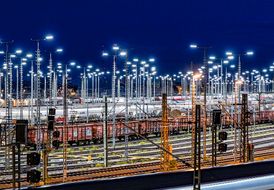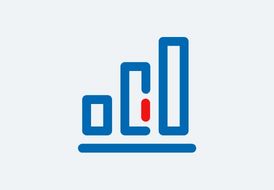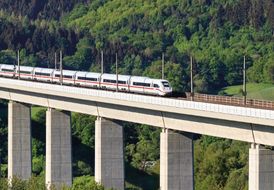Development in the year under review
- Positive development of demand, mainly as a result of the resumption of transport services.
- Rental business continues to be greatly burdened by effects of the Covid-19 pandemic.
- Additional burdens due to effects of collective bargaining and external influences such as severe weather.
- Measures were implemented to save energy and to ensure and improve the quality of customer satisfaction.
| DB NETZE STATIONS | 2021 | 2020 | Change | 2019 | ||
absolute | % | |||||
Passenger stations | 5,399 | 5,397 | +2 | – | 5,384 | |
Facilities quality (grade) | 2.77 1) | 2.83 1) | – | – | 2.87 | |
Customer satisfaction, traffic station (passengers/visitors) (SI) | 73 | 72 | +1 | – | 69 | |
Customer satisfaction, traffic station | 69 | 68 | +1 | – | 61 | |
Customer satisfaction, tenants (SI) | 79 | 77 | +2 | – | 79 | |
Station stops (million) | 155.5 | 152.2 | +3.3 | +2.2 | 153.3 | |
thereof non-Group railways | 46.0 | 44.0 | +2.0 | +4.5 | 40.0 | |
Total revenues (€ million) | 1,285 | 1,258 | +27 | +2.1 | 1,339 | |
thereof station revenues (€ million) | 966 | 917 | +49 | +5.3 | 905 | |
thereof rental (€ million) | 302 | 332 | –30 | –9.0 | 393 | |
External revenues (€ million) | 520 | 525 | –5 | –1.0 | 590 | |
EBITDA adjusted (€ million) | 160 | 171 | –11 | –6.4 | 349 | |
EBIT adjusted (€ million) | 1 | 24 | –23 | –95.8 | 210 | |
Gross capital expenditures (€ million) | 1,380 | 1,338 | +42 | +3.1 | 1,096 | |
Net capital expenditures (€ million) | 297 | 253 | +44 | +17.4 | 262 | |
Employees as of Dec 31 (FTE) | 6,811 | 6,525 | +286 | +4.4 | 6,216 | |
Annual average employees (FTE) | 6,768 | 6,375 | +393 | +6.2 | 6,038 | |
Employee satisfaction (SI) | – | 4.0 | – | – | – | |
Share of women as of Dec 31 (%) | 44.1 | 44.2 | –0.1 | – | 44.7 | |
Absolute primary energy consumption (stations) compared to 2010 (%) | –27.4 | –25.7 | –1.7 | – | –22.1 | |
1) Preliminary figure.
The facilities quality remained at a good level.
Customer satisfaction among passengers/visitors increased again, especially at the stations in the economic stimulus program. The survey is conducted on the basis of about 80,000 interviews per year. Customer satisfaction for train operating companies and contracting organizations also improved slightly. Despite the ongoing Covid-19 pandemic, customer satisfaction among tenants increased and returned to its pre-pandemic level.
The increase in station stops resulted mainly from the resumption of transport services, which were temporarily reduced due to Covid-19. The main driver was the higher demand from intra-Group and external customers in regional transport. Overall, the pre-Covid-19 level was exceeded.
On the other hand, the economic development continued to prove challenging, with operating profit figures declining significantly due to additional expenses, in particular because of support measures for tenants in connection with the Covid-19 pandemic. These were only partially offset by income growth:
- The increase in revenues was due to higher station fees as a result of price and volume factors. Lower rental revenues had a dampening effect, due in particular to Covid-19. Lower rental revenues due to renovation measures at stations placed an additional strain on income growth.
- Other operating income (+54.2%/€ +103 million) increased significantly, driven by higher grants in connection with support programs for the renovation of stations (Federal Government’s trade program).
In terms of expenses, there were considerable additional burdens from the cost of materials and personnel expenses:
- The costs of materials (+17.1%/€ +118 million) increased, in part because of additional hygiene and safety measures at our stations made necessary by Covid-19, and also because of the Federal Government’s trade program stimulus package, though this did not affect profits overall. Price increases, including for energy and services, resulted in additional burdens.
- Personnel expenses (+10.7%/€ +43 million) increased as a result of a higher number of employees and collective bargaining agreements.
- Depreciation (+8.2%/€ +12 million) increased significantly due to capital expenditures.
- Other operating expenses (+1.1%/€ +3 million) increased slightly. In addition to the absence of a one-time effect that reduced expenses in 2020, expenses rose due to higher expenses for rent and IT projects, among other things. This was offset partly by the effects of lower impairments on receivables and a decline in travel activity due to Covid-19 effects.
Due to higher gross capital expenditures, mainly in the modernization of existing stations and the construction of new stations, net capital expenditures increased significantly, with investment grants virtually unchanged.
As of December 31, 2021, the number of employees increased, mainly as a result of an increase in personnel in construction and facilities management.
The share of women remained almost unchanged at a relatively high level.
With a further reduction in absolute primary energy consumption of stations in comparison to 2010, including through the use of energy-saving technologies, the positive trend of the past years is continuing.



